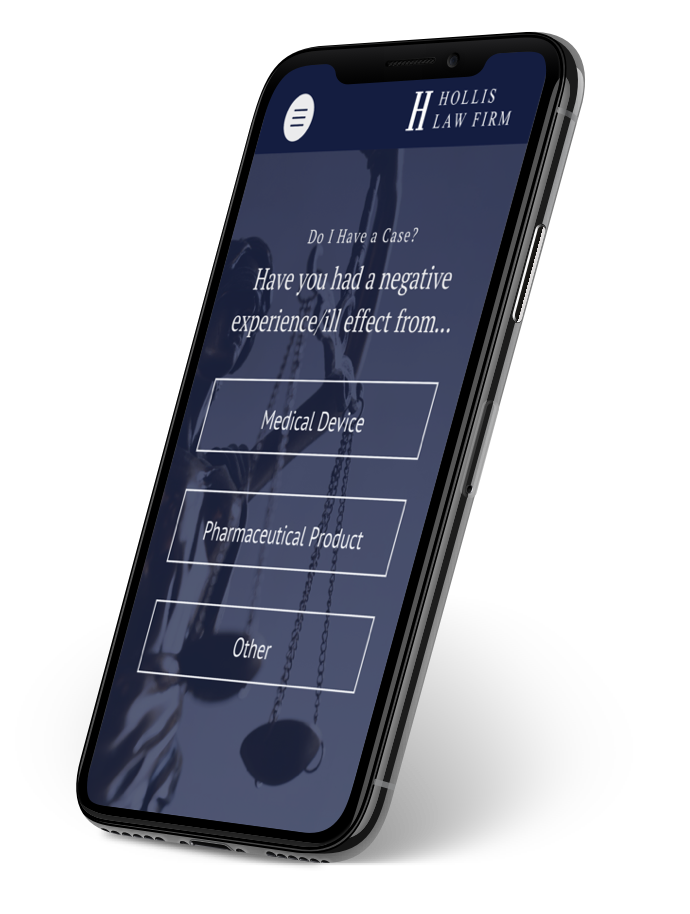Looking for representation in the IVC lawsuit? Our experience, expertise, and resources make Hollis Law the ideal partner.
An inferior vena cava (IFC) filter is a device used to prevent pulmonary embolisms after experiencing an event that may increase the likelihood of blood clots. In the vascular system, the IVC is the major vein that brings oxygen depleted blood from the lower half of the body to back to the heart. An IVC filter can be placed to catch potential blood clots and keep them from advancing to the heart and lungs.
Introduction
Many patients have alleged that pieces of the IVC filter have broken or migrated causing perforations, an increased risk of blood clots, or even death.
History of the Case
On August 9, 2010, the Food and Drug Administration issued a warning to healthcare providers and physicians regarding complications stemming from the use of surgically implanted retrievable Inferior Vena Cava Filters. From 2005 to 2010, the FDA was made aware of 921 reported adverse events involving instances of device migration (movement of the device within the vessel), embolizations (detachment of device components), perforation of the Inferior Vena Cava, and filter fracture. These complications resulted in adverse clinical outcomes in some patients, and may have been in a factor in the death of a few patients.
The Inferior Vena Cava (or IVC), is a large vein in the lower trunk and abdomen that carries blood from the lower body back to the heart. Surgeons, for patients who have suffered a deep vein thrombosis (DVT), pulmonary embolism (PE), or have been unsuccessfully treated with anticoagulants, may employ an IVC Filter to reduce the risk of a patient developing additional PE or other injuries. These Filters are about the same diameter as a quarter and consist of multiple metal arms radiating out from a central spindle that are implanted into the IVC. Once in position, the arms will press against the walls of the vessel and the device will act as a cage to capture any blood clots traveling toward the heart and lungs from the lower body.
These Filters have been in use since the late 1970s, but have increased in popularity over recent years. However, concerns have risen as these filters are only for short-term placement in patients ineligible for traditional anticoagulant therapy and are designed to be retrieved by the surgeon once a patient’s risk for PE subsides. Unfortunately, many of these devices are implanted in patients unnecessarily and are left in the patient beyond this useful life.
In November 2010, Dr. William Nicholson and several colleagues published an article about the complications stemming from the use of the IVC Filter. These complications involved the arms of the filter eroding through the wall of the vessel, fracturing of one or more filter arms and the subsequent migration of the pieces to the heart, perforation of organs, migration of the filter, and other serious injury. One manufacturer’s product, the study showed, had an overall fracture prevalence of 25%. In these situations, patients may require surgery to remove the fragments and in rare cases may suffer a perforation allowing fluid to build up around the heart requiring emergency intervention.
Injuries Related To Product
Symptoms
- DVT
- Filter fracture
- Embolization of components
- Perforation of vessels or organs
- Filter migration
- Hemorrhage
- Cardiac or pericardial tamponade
- Injury to heart lung, or vena cava
- Severe chest pain
- Death
Additional Literature
FDA; FDA Initial Communication: Removing Retrievable Inferior Vena Cava Filters; 8/9/2010
Nicholson, William, M.D., et al; Prevalence of Fracture and Fragment Embolization of Bard Retrievable Vena Cava Filters and Clinical Implications Including Cardiac Perforation and Tamponade; Arch. Intern. Med., vol. 170; Nov. 8, 2010… Continue
Do I Have a Case?
Give us a few details about your concerns and our case tool will help you get the answers you need.










